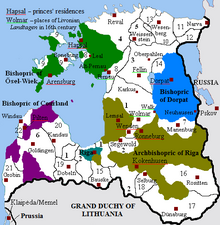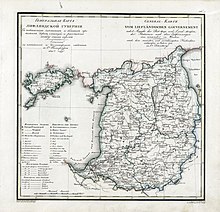
Back Lyfland Afrikaans Livonia AN ليفونيا Arabic Livonia AST Livoniya Azerbaijani Лівонія Byelorussian Лівонія BE-X-OLD Ливония Bulgarian Livònia Catalan Livonsko Czech



Livonia[a] or in earlier records Livland,[1] is a historical region on the eastern shores of the Baltic Sea. It is named after the Livonians, who lived on the shores of present-day Latvia.
By the end of the 13th century, the name was extended to most of present-day Estonia and Latvia, which the Livonian Brothers of the Sword had conquered during the Livonian Crusade (1193–1290). Medieval Livonia, or Terra Mariana, reached its greatest extent after the Saint George's Night Uprising of 1343-1345, which forced Denmark to sell the Duchy of Estonia (northern Estonia conquered by Denmark in the 13th century) to the State of the Teutonic Order in 1346. Livonia, as understood after the retreat of Denmark in 1346, bordered on the Gulf of Finland in the north, Lake Peipus and Russia to the east, and Lithuania to the south.
As a consequence of the 1558–1583 Livonian War, the territory of Livonia was reduced to the southern half of Estonia and the northern half of Latvia.
The indigenous inhabitants of Livonia were various Finnic tribes in the north and Baltic tribes in the south. The descendants of the crusaders formed the nucleus of the new ruling class of Livonia after the Livonian Crusade, and they eventually became known as Baltic Germans.
Cite error: There are <ref group=lower-alpha> tags or {{efn}} templates on this page, but the references will not show without a {{reflist|group=lower-alpha}} template or {{notelist}} template (see the help page).
- ^ Kropotkin, Peter Alexeivitch; Bealby, John Thomas (1911). "Livonia". Encyclopædia Britannica. Vol. 16 (11th ed.). pp. 816–817.
© MMXXIII Rich X Search. We shall prevail. All rights reserved. Rich X Search